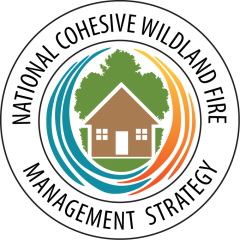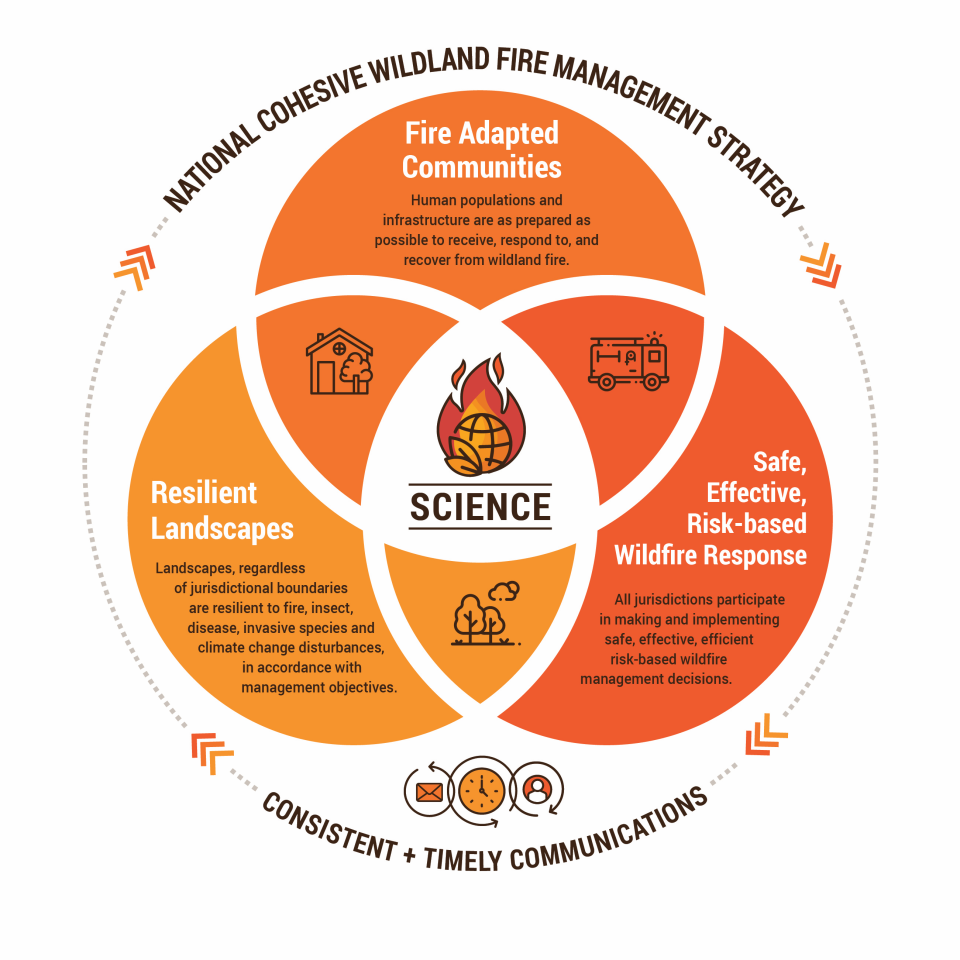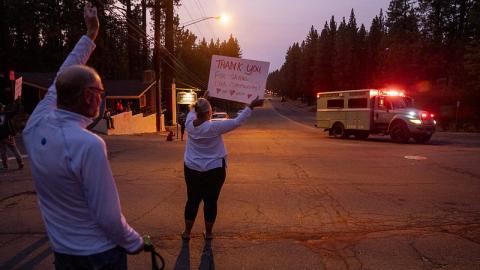Q&A on the Cohesive Strategy
The National Cohesive Wildland Fire Management Strategy (Cohesive Strategy) is the strategic framework for addressing wildland fire challenges across the nation. The Wildland Fire Leadership Council recently completed a year-long review of the Cohesive Strategy and found that it is still relevant and valid as a strategy for changing the outcomes of wildland fire in the United States. The review also revealed a number of areas that were not addressed in the original 2014 framework or were not addressed in depth as well as specific challenges to implementing the Cohesive Strategy.
We connected with Katie Lighthall, Coordinator for the Western Region of the Wildland Fire Leadership Council, to learn more. The below Q&A outlines the Cohesive Strategy Addendum and its connection to the original 2014 Cohesive Strategy framework.

Q: First off, what is the National Cohesive Wildland Fire Management Strategy?
A: The National Cohesive Wildland Fire Management Strategy (Cohesive Strategy) was developed in 2014 to serve as the key strategic framework for addressing wildland fire challenges across the nation and provide guidance to all levels of stakeholders seeking to change the negative trajectory of wildland fire.
Q: What is your role in this process?
A: As Coordinator for the Western Region my primary role is to facilitate implementation of the Cohesive Strategy. I spend a lot of time with stakeholders across the western U.S., helping them understand what the Cohesive Strategy is, and what implementation of it looks like for them. Implementation looks different for every organization, at every level.
Q: What is the Addendum Update?
A: The National Cohesive Wildland Fire Management Strategy Addendum Update (the Addendum) is a strategic look at the critical drivers affecting the wildland fire management system today and key implementation challenges which were not addressed or have become challenges in the 10 years since the development of the original 2014 Cohesive Strategy framework.
The Addendum includes new and updated language for the vision and goals, and management options to help stakeholders work better together for better wildland fire outcomes.
The Addendum includes strategic direction for the future and approved modifications to address the identified critical emphasis areas and challenges to Cohesive Strategy implementation.
Q: Does this Addendum replace the original Cohesive Strategy?
A: The Addendum is considered merged with the 2014 National Cohesive Wildland Fire Management Strategy and is known conversationally as “the Cohesive Strategy.”

Q: What are the new goals and vision?
A: The new vision is “To safely and effectively extinguish fire, when needed; use fire where allowable; manage our natural resources; and collectively, learn to live with wildland fire.”
Updated goals include:
- Resilient Landscapes – Landscapes, regardless of jurisdictional boundaries are resilient to fire, insect, disease, invasive species and climate change disturbances, in accordance with management objectives.
- Fire Adapted Communities – Human populations and infrastructure are as prepared as possible to receive, respond to, and recover from wildland fire.
- Safe, Effective, Risk-based Wildfire Response – All jurisdictions participate in making and implementing safe, effective, efficient risk-based wildfire management decisions.
Q: What are the new areas of focus?
A: The Addendum addresses four critical emphasis areas, that surfaced as either not identified or addressed in depth in the 2014 Cohesive Strategy framework and are driving the impacts of wildland fire. These are in addition to the four that were recognized in the 2014 Cohesive Strategy framework - Vegetation and fuels; Homes, communities and values at risk; Human-caused ignitions; and Effective and efficient wildfire response.
- Climate change;
- Workforce capacity, health and well-being;
- Community resilience (preparation, response and recovery); and
- Diversity, equity and inclusion, and environmental justice.
Q: What are the implementation challenges?
A: The Addendum exposes five key implementation challenges:
- The existing wildland fire management system has not kept pace with demands.
- There is still a need for significant increase in the use of proactive fire (prescribed and managed wildfire for resource objectives) across the country.
- Science, data, and technology have not kept pace with the extent of wildland fire and postfire impacts, or been fully integrated into decision-making for fire, land, and community managers.
- Markets, infrastructure, and skilled human resource capacity are inadequate to utilize biomass and other wood products from ecosystem management or hazardous fuel treatments.
- Education, communications, and marketing are insufficient to inform stakeholders and decision-makers about Cohesive Strategy implementation.
The Wildland Fire Leadership Council will be prioritizing and developing how to collectively address these challenges going forward.
Q: How does the Cohesive Strategy fit with other current efforts and strategies such as the USDA Forest Service Wildfire Crisis Strategy, the DOI Wildfire Risk Five-Year Plan, State and Tribal plans, and Community Wildfire Protection Plans?
A: All of these efforts are explicit responses to wildland fire challenges in specific areas, and are examples of implementing the Cohesive Strategy at specific levels – from the highest national agency stages to the most local, grassroots levels. Each of these strategies reflects efforts to work across boundaries with stakeholders and partners to reduce the risks of loss from wildland fire – the fundamental principle of the Cohesive Strategy.
Q: How does the Cohesive Strategy intersect with the Wildfire Mitigation and Management Commission and the Wildfire Resilience Interagency Working Group?
A: The Wildfire Commission is charged with recommending ways that Congress can further support implementation of the Cohesive Strategy and will be providing those recommendations in the final report due to Congress in September 2023. With the Cohesive Strategy Addendum highlighting issues not previously identified, the support Congress can offer will have a greater impact across the full spectrum of wildland fire challenges and opportunities. This will enable the Wildland Fire Leadership Council to address those needs over the long-term.
The Interagency Working Group embraces the original Cohesive Strategy Framework (2014) and the Addendum Update, and strives to create more efficient and impactful federal family approaches to addressing wildland fire challenges and needs.
Q: What’s in it for other agencies, states, tribes, counties, or NGOs?
A: It is no longer possible to address all the issues in the wildland fire environment as one agency, one state, one tribe, one organization, one county, or one neighborhood. The Cohesive Strategy pushes us to challenge our current and historical approaches to our rapidly changing wildfire realities and reach beyond our individual silos and jurisdictions to collectively:
- Define and understand our risk;
- Collaboratively set landscape level and community-wide priorities;
- Share and co-manage risk across boundaries and jurisdictions;
- Accept some short-term risk for long-term benefit; and
- Collectively invest in outcome-based approaches and activities, rather than outputs.
If your efforts align with these actions, you are implementing the Cohesive Strategy and your chances of achieving the three goals is greatly multiplied.
Q: What does this look like?
A: Implementation looks different across all organizations -
For land management agencies – the opportunity to collaborate with cross-boundary stakeholders to prioritize, implement and communicate around activities results in the right acres treated to restore landscapes and reduce the risk of high intensity wildfire, community protection and resiliency, and a safer wildland fire environment in which firefighters can work.

For state and fire protection agencies with responsibility to landowners for fire suppression – the opportunity to collaborate with landowners to prioritize risks and future fire management planning results in priorities with the tradeoffs understood and accepted by all parties.
For non-governmental organizations with specific missions – the opportunity to collaborate with federal, state, tribal, and local stakeholders allows for unique and perhaps historically marginalized voices to be heard, and be a valuable part of the identification, prioritization, and co-management of risk, as well as part of the collective investment in outcome-based approaches.
For members of the public - the opportunity to learn more about the realities of our current situation and the uncomfortable truths of how we will get out of it leads to a greater understanding and acceptance of what must be done to change the negative trajectory.
All of these contribute to cross-boundary efforts where the “all hands - all lands” approach leads to greater landscape resiliency, community resiliency and fire adaptation, and a safer, more effective, wildfire response.
Q: Why is this so important?
A: Across the U.S., we have reached a tipping point where we can no longer address these issues in the same way we have for 50-100 years. The negative trajectory of wildland fire in the U.S. (increasing lives and property lost, natural resources and habitat lost, increasing negative impacts to communities and economies, and skyrocketing costs of fire suppression) will overtake our collective ability to respond to these issues if we don’t act now. We must reach outside our comfort zones and do business differently if we are to make significant progress towards landscape resiliency, resilient and fire adapted communities and a safer, more effective wildfire response. The Cohesive Strategy shows us how to do that.
Q: Any closing thoughts?
As we stand on the precipice of a new wildland fire paradigm, we have the opportunity to define it, not be defined by it. If we are to make significant progress toward the three goals, and change the negative trajectory of wildland fire, we cannot stop the momentum, but must double down on our cross-boundary efforts.
If you’d like to talk more about how the Cohesive Strategy can be applied in your wildland fire space, please give Katie Lighthall a call at 541-408-3048 or via email at westerncohesivestrategy@gmail.com.
To learn more about the Cohesive Strategy, visit wildfireinthewest.org.